
Firs are evergreen coniferous trees belonging to the genus Abies in the family Pinaceae. There are approximately 48–65 extant species, found on mountains throughout much of North and Central America, Europe, Asia, and North Africa. The genus is most closely related to Cedrus (cedar).

Picea abies, the Norway spruce or European spruce, is a species of spruce native to Northern, Central and Eastern Europe.

Abies grandis is a fir native to western North America, occurring at altitudes of sea level to 1,700 metres (5,600 ft). It is a major constituent of the Grand Fir/Douglas Fir Ecoregion of the Cascade Range.
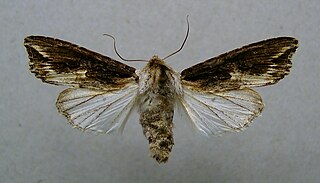
Egira is a moth genus in the family Noctuidae. This genus has several species, including Egira crucialis, that are on wing in winter and early spring. They are sometimes, along with members of the Orthosia genus, called early spring millers.
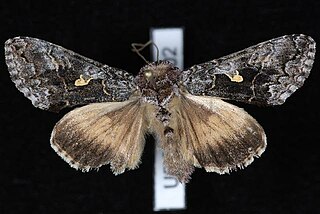
Syngrapha celsa, the plain silver Y or western conifer looper, is a moth of the family Noctuidae. The species was first described by Henry Edwards in 1881. It is found in North America from British Columbia to California, Idaho, Nevada, Arizona and New Mexico.

Epinotia nanana, the European spruce needleminer, is a moth of the family Tortricidae. It is found from northern and central Europe to Russia and Mongolia.

Nematocampa resistaria, the filament bearer, bordered thorn or horned spanworm moth, is a moth of the family Geometridae. The species was first described by Gottlieb August Wilhelm Herrich-Schäffer in 1856. It is found in North America from British Columbia to Nova Scotia, south to Florida and California.
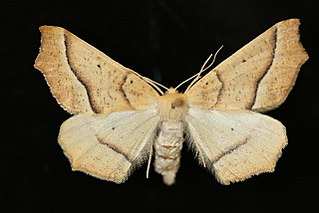
Tetracis pallulata is a moth of the family Geometridae first described by George Duryea Hulst in 1887. It is found in western North America from southern California north to British Columbia, east to Idaho and western Montana from near sea level to 2,200 meters.
D. californica may refer to:
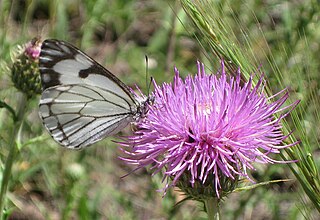
Neophasia menapia, the pine white, is a butterfly in the family Pieridae. It is found in the western United States and in southern British Columbia, Canada.

Orgyia pseudotsugata, the Douglas-fir tussock moth, is a moth of the subfamily Lymantriinae first described by James Halliday McDunnough in 1921. It is found in western North America. Its population periodically irrupts in cyclical outbreaks. The caterpillars feed on the needles of Douglas fir, true fir, and spruce in summer, and moths are on the wing from July or August to November.
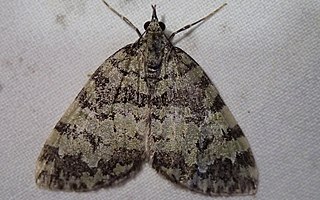
Hydriomena speciosata is a moth of the family Geometridae. It is found from coastal British Columbia south to California. The habitat consists of wet conifer forests.

Nepytia umbrosaria is a moth of the family Geometridae first described by Alpheus Spring Packard in 1873. It is found in North America, including Arizona, British Columbia, California, Oklahoma, Oregon and Washington.
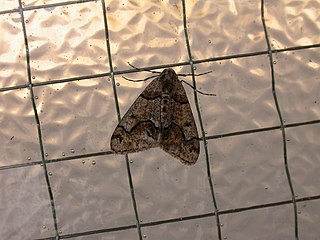
Gabriola dyari, or Dyar's looper, is a moth of the family Geometridae first described by Taylor in 1904. It is found from the Alaskan panhandle and British Columbia to California. The habitat consists of coniferous forests.

Eupithecia longipalpata is a moth in the family Geometridae. It is found from coastal British Columbia south to California.
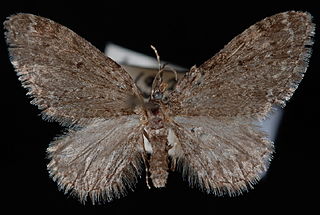
Eupithecia annulata, the larch pug moth, is a moth in the family Geometridae. The species was first described by George Duryea Hulst in 1896. It is found in North America from British Columbia north to the Yukon, east to Newfoundland and Labrador and south to California and Colorado.

Eupithecia olivacea is a moth in the family Geometridae first described by Taylor in 1906. It is found in North America from British Columbia south through Washington and Oregon to California.

Acleris nigrolinea is a species of moth in the family Tortricidae. It is found in North America, where it has been recorded across Canada from British Columbia to New Brunswick, and in the United States as far south as California, Arizona, Tennessee and North Carolina.

Chionodes abella is a moth in the family Gelechiidae. It is found in North America, where it has been recorded from Idaho and south-western British Columbia to Colorado, Texas and California.

Euxoa tristicula, the early cutworm, is a moth of the family Noctuidae. It was first described by Herbert Knowles Morrison in 1876 and is found in the United States and Canada, where it ranges from southern British Columbia, south through Oregon to central California along the coast.




















